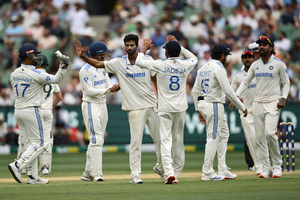
The awesome and aggressive way in which the young Australian opener, Sam Konstas, debuted in the fourth Test match between India and Australia, seems to be the trend the young Gen Z will follow. For him to play ,as one can describe, gully cricket shots against the world’s best pacer, Jasprit Bumrah, was truly an eye opener.
One needs quick reflexes, a great eye, and flexible foot movement—all traits of a youngster—to play in this bizzare manner. One did see it in the batting of Yashasvi Jaiswal, Suryakumar Yadav, and Rishabh Pant and many of the present young cricketers as well; however, for a debutant to do so with such confidence truly establishes this transformation that one will see in Test cricket in the future.
Making the 360-degree shot has come to stay and one that will be a pain for not only the bowlers but also for the captains as regards field placements.
The limited-overs cricket and especially T20, along with the protective gear have made the batter far more daring and brash. In the earlier days, one did not venture to do so for fear of being severely injured. The cricket ball is a hard and round missile that can be extremely lethal and painful when one gets hit by it. The helmet and a few paddings to safeguard a batter have interestingly brought about a new dimension to stroke play.
The first icon of such an innovative transformation was Ranjitsinh. His subtle wrist innovated the leg glance at a time when batsmen were more prone to hit the ball straight and hard. One gathers that the great Ranji in school while facing fast bowlers was stepping back and hence his coach and principal, Mr. Mcnaughtan, put nails at the back of his feet to prevent him from doing so. Ranjitsinh’s only option to protect himself from being hit on the thigh and leg was to get the bat quickly in place and thus the leg glance and flick came into existence.
The thick and meaty bats are making batting into a different art. The reverse flick now being played both on the off and leg side as well as over the keeper is one such innovation. The reverse sweep and glide over the slips is another. All this is possible because of the modern willow, one that has made run scoring far easier.
Calypso cricket was what made West Indies cricket popular. They played the game to entertain the spectators in a very similar fashion to the Brazilian way of playing football. However, over time, the carefree approach led to a more constructive and planned one. Test cricket too went through that phase. The interesting part is that it is transforming itself into the old way of aggressive stroke play. Cricket has become an entertainment platform and cricketers are realising that to be stars, one has to rise above the mundane ways and come up with something special.
One feels sorry for the present cricketers, who are mentally in the fast-forward mode of the present world having to play a game that is a five-day affair requiring patience and a conservative approach. The confusion of deciding one’s approach for a modern-day player can be quite difficult.
A Steve Smith, Marnus Labuschagne, Kane Williamson, Joe Root and Virat Kohli are all products of batters who started their career before the introduction of T20 cricket. They are all the proven success models of Test batsmanship. The problem they are facing now is to adapt as match winners in the shortest format of the game, whereas the present batters are struggling in the longer version to showcase consistency.
The change one sees is the gradual disappearance of the old traditional way of batsmanship. Cricket will then go full circle. The aggressive mode of cricket started with village cricket in England, wherein a batsman was not called manly enough if he did not attack the bowler. A century and more later, the approach is becoming similar. The art of gully cricket and it’s boldness is taking shape and Sam Konstat displayed it recently.
Cricket is becoming more attractive to watch because teams are more geared towards obtaining a result. This is leading to matches struggling to last 5 days. A movement to shorten Test cricket is being strongly debated at the ICC. This would be an error and a folly as even the last battle of differentiating it from the limited versions will dwindle. The game of cricket will then become a slam bang affair and the art of patience and survival through a difficult situation will become a thing of the past.
In Test cricket, one still feels the traditional way of batsmanship is the way to success. Maybe, like a nice blended whisky, a mixture of gully with guile may be the perfect solution.
(Yajurvindra Singh is a former India cricketer. The views expressed are personal.)
–IANS
bc/






